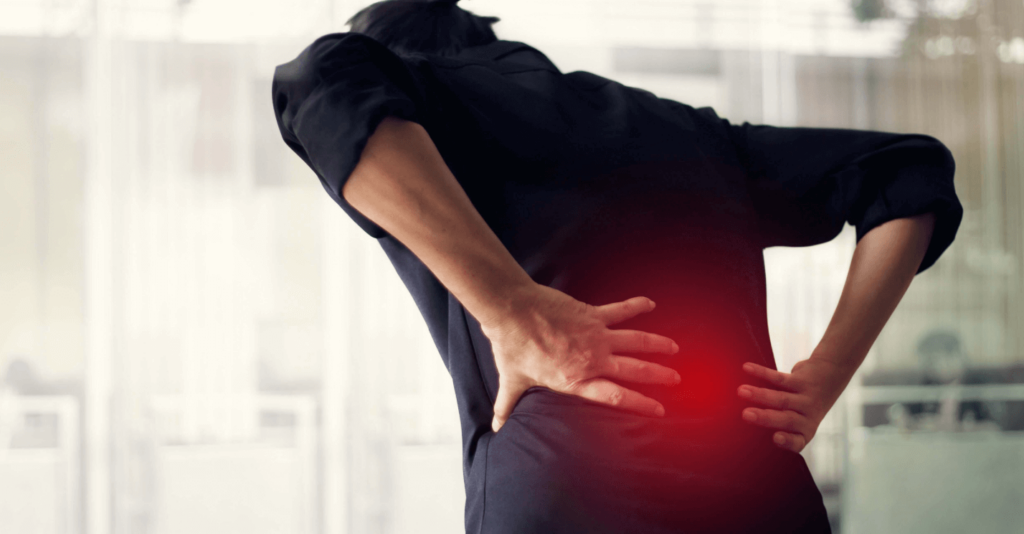Disc Bulge Pain: What Is It and How to Find Relief

If you have ever had discomfort or pain in your low back or tingling down your leg, then it’s possible you have suffered from a disc bulge.
A disc bulge is when the jelly-like material inside of one of the discs found between the bones of the spine pushes its way toward the edge of the disc. They can be painless, but can also be the cause of low back pain or other symptoms (tingling, weakness, numbness, pins and needles) down the leg.
A patient success story…
As a physiotherapy student, I have seen several patients come in with these symptoms and are unsure what to do. Take for example one patient I recently saw who injured their back helping a friend move. Working together we developed a plan to help them take control of their pain and return to their activities.
“As a young and healthy woman with no previous low back pain, I figured helping my friend move would be a piece of cake. I went to lift a heavy, awkwardly shaped box from the floor and felt instant pain in my back. For a week I was hardly able to sit down and had shooting pain down my leg. From my first session at SOS working with a physiotherapist and a student, I got relief. They explained to me that I had a disc bulge and put me on a treatment plan to get me back to the things I love. Weeks later, I am pain free and back at the gym!” -Bev
In this post, we’ll explain what causes a disc bulge, the signs and symptoms you can look for to determine if you have a disc bulge, and how to find relief from your pain.

What Is a Disc Bulge?
The spine is made up of a series of bones (vertebrae) that are separated by discs. These discs are built like a jelly donut – a jelly-like material is found in the middle surrounded by multiple rings of tough tissue. They play a large role in cushioning the spine and keeping it flexible during everyday tasks and movements.

When the inner jelly of the disc pushes out of the centre and into the outer rings, this is called a disc bulge. If the jelly continues to move outward tearing through the rings, it then becomes a disc herniation. The further it moves towards the edge, the higher the chance that it can press on nerves that exit the spine. This is when you feel pain or symptoms down the leg.
You may hear many different names when people talk about disc injuries – bulge, herniation, and slipped disc are just to name a few. These all relate to a disc injury but might be used differently based on the amount the jelly has moved!
What Causes a Disc Bulge?
Like most things, there does not appear to be a single cause for a disc bulge. Research suggests it can be due to a combination of things like genetics, natural changes of aging, or an injury from overloading the spine. The pain may have come on suddenly, but often a disc bulge is the result of a gradual process irritated by an innocent or common movement.
What are the Signs and Symptoms of a Disc Bulge?
Each person’s pain experience and symptoms will be different. Some common signs and symptoms of a disc bulge are:

- Low back pain in the centre or on either side.
- Pain that travels down one leg into the buttock, thigh, calf, and/or foot. You may also feel a burning, stinging, pins and needles, or numbness sensation.
- Symptoms get worse with movements like sitting and bending forward (to pick something up, tie shoes, etc.).
- Sore and stiff first thing in the morning, and pain at night with sleeping (may wake you up).
- Change to what touch feels like on one leg (ex. your pants may feel different on one leg).
- Weakness in one leg (ex. your toe is dragging while you walk).
When we sit or bend forward, the bones in our spine move in a way that places more pressure on the front part of our disc. With a disc bulge, the pressure on the front causes the jelly to be pushed further backward. This increases the pressure placed on the tough rings and nerves which creates more pain or symptoms.
What You Need to Know About Your Disc Bulge
Experiencing low back pain with symptoms down the leg can be scary, but it doesn’t need to be.
Despite what we think, the spine is extremely strong and has a great ability to heal. A disc bulge can heal on its own in 3-6 months. With help from a physiotherapist or other healthcare provider it often has a great outcome.

With an injury to the low back, it is important to be aware of signs and symptoms of when something more serious may be going on.
The nerves that supply the bowel, bladder, and sex organs can become pushed on with a disc herniation in rare cases, creating a loss in function known as Cauda Equina Syndrome. This is a medical emergency that requires immediate attention.
If you have any of the following symptoms since your back pain started, seek emergency medical help within 24 hours:
- Loss of feeling or pins and needles between your inner thighs, genitals, or buttock.
- Changed feeling when wiping with toilet paper.
- Difficulty with trying to control urination or a bowel movement.
- Loss of sensation with urination or passing a bowel movement.
- Difficulty with trying to urinate.
- Leaking urine.
- Not knowing when your bladder is full or empty.
- Loss of sensation in genitals during sexual intercourse.
- Change in ability to achieve an erection or ejaculate.
Tips to Reduce Pain Caused by Your Disc Bulge
Having a disc bulge can be painful, but that doesn’t mean there is nothing you can do to help it. Below are some tips to get your disc bulge pain under control:
- The next posture is the best posture! Sitting will increase your symptoms, so avoiding this as much as possible is key to controlling your pain. This can be difficult, but taking breaks to stand every 20-30 minutes will help to reduce your pain.
- Support your back! When sitting at your desk or driving in the car having some type of low back support keeps the spine in a neutral position. You can purchase a lumbar support roll, or use something found around the house. A small cushion or rolled up towel can work really well when placed between the back of the chair and the natural curve of your low back.

3. Stay active! Even though you may be feeling pain, staying active has so many benefits for injury recovery and your overall health. Walking for 30 minutes a day is a good place to start to see positive effects.
Here is a video of some exercises you can try to start getting your disc bulge under control. NOTE: if any of these make you feel worse, stop and consider consulting with a physiotherapist.
4. See a physiotherapist! A physiotherapist be your guide during recovery from a disc bulge. We will get to know you to develop a specialized plan and get you back to what you enjoy doing! Treatment will be specific to you and may include a combination of exercises, education, manual therapy, dry needling/acupuncture, or laser therapy.


Contact Us to Help Fix Your Pain!
If your story sounds similar to Bev’s or these symptoms sound familiar consider seeing one of the physiotherapists at SOS. Fill out this form with your information and we will contact you to book a time that works for you to come in and get on the road to recovery and doing what you love again!
FAQ’s
Pain in your leg can be due to a number of reasons. The easiest way to know if the source if your low back is if your leg symptoms change based on movements in your low back. If changes in posture (like sitting or bending forward) cause the symptoms down your leg to increase, then it is likely a problem in your lower back!
This is a very common question asked by patients, and oftentimes the answer is no (at least not right away). Research shows that image findings frequently don’t match with symptoms patients are experiencing – there can be findings in a person that experiences no symptoms, and no findings in a person that has severe symptoms. If after time and conservative treatment your symptoms are not improving or are worsening, then it may be time to return to your doctor for further evaluation.
As a rule of thumb, any exercise or stretch that promotes bending in the spine (like crunches, child’s pose, touching toes) should be avoided since this pushes the jelly in the disc closer to the nerves. Instead, positions that encourage straightening or arching your back such as lying on your stomach propped up on your elbows or arching your back while standing will help to move the jelly back toward the centre of the disc. A physiotherapist can provide you with more personalized options that are specific to what activities you want to return to.
A disc bulge is an injury to a disc, where sciatica is the symptoms you might feel. Sciatica is commonly used to refer to pain or symptoms travelling down the back of the leg and into the foot in the pattern of the sciatic nerve. A disc bulge can cause sciatica, but it depends where in the spine it is. If the bulge is at a higher level, it may cause symptoms in the leg that are not in the sciatic nerve distribution (ex: front of the thigh).

